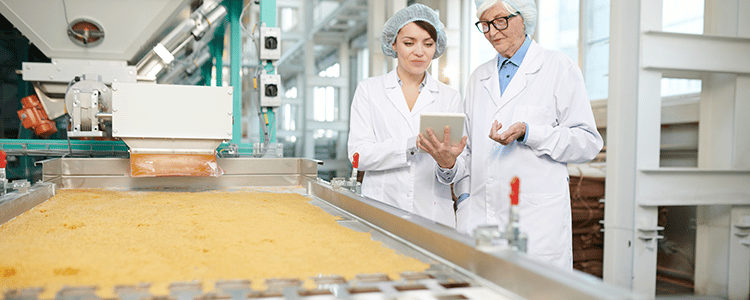In the food and beverage sector, technological advancements are helping organizations enhance operational efficiency and reshape consumer interactions.
As a CIO, it’s essential to understand current innovations and the latest technology trends in the food and beverage industry. This post explores food and beverage industry examples of how modern software systems are solving traditional challenges and what businesses must do to stay competitive.
F&B Technology Trends to Guide Your Software Selection
1. More Comprehensive ERP Functionality
Enterprise resource planning (ERP) systems have evolved from mere tools for managing finance and inventory to strategic solutions that integrate all facets of a business. Today, these systems are helping food and beverage businesses manage complex supply chains, production processes, and customer relationships.
If your company needs a solution tailored to the manufacturing industry, a modern manufacturing ERP system might be worth considering. These platforms streamline administrative and operational tasks, such as compliance tracking and quality assurance. At the same time, they provide analytics and reporting tools to optimize resource allocation and production planning.
2024 Top 10 Manufacturing ERP Systems Report
Are you a mid- to large-sized manufacturing firm? This report is for you. Download it now to learn what kind of advanced functionality is available in the market today.
2. IoT and Smart Manufacturing
The Internet of Things (IoT) is revolutionizing manufacturing processes in the food and beverage industry. IoT devices collect and analyze data from various stages of production to monitor quality control, manage inventory levels, and ensure equipment efficiency.
For example, smart sensors on production lines can detect potential defects or contaminations before they become critical. In addition, these sensors can help managers perform tasks such as:
- Maintaining safe temperatures
- Counting inventory
- Monitoring equipment performance
An innovative application of IoT can be seen in breweries where sensors monitor the fermentation process, adjusting conditions in real-time to ensure a quality brew.
3. AI and Machine Learning for Demand Forecasting and Personalization
Artificial intelligence (AI) and machine learning (ML) are helping F&B companies predict consumer demand and personalize customer experiences. By analyzing vast amounts of data, these technologies can forecast buying patterns and preferences with high accuracy.
For example, a snack company might use ML to analyze purchase data and social media trends, allowing the company to anticipate dietary trends. At the same time, it might use AI-driven chatbots and recommendation systems to personalize marketing and enhance customer engagement.
(Learn about AI in the food and beverage industry)
4. IT Infrastructure Advancements
As food and beverage companies integrate cutting-edge technologies, the necessity for robust IT infrastructure has become apparent.
Our ERP software consultants frequently tell clients that an optimized IT infrastructure is crucial for handling increased data volumes and complex system integrations.
Here’s a look at the key elements of an optimized infrastructure:
- Scalable Cloud Solutions – Many F&B companies are transitioning to cloud computing to ensure scalability and flexibility. Cloud platforms allow businesses to manage vast amounts of data, facilitating seamless operations and real-time analytics.
- Advanced Network Architectures – The adoption of Software-Defined Wide Area Networks (SD-WAN) is growing. SD-WAN provides enhanced connectivity, reliability, and control when it comes to applications used across multiple locations. This is especially crucial for companies with extensive distribution channels.
- Enhanced Cybersecurity Measures – As digital data becomes more integral to operations, protecting this data has risen in priority. F&B companies are investing in sophisticated cybersecurity solutions to safeguard sensitive information from breaches and cyber threats.
5. Blockchain for Enhanced Traceability and Transparency
F&B manufacturers are increasingly using blockchain technology to improve traceability and transparency in the food supply chain.
This trend is particularly relevant given the growing consumer demand for ethical sourcing and sustainability. Blockchain enables immutable recording of every transaction or product movement on a supply chain.
For instance, a seafood distributor might use blockchain to allow consumers to track the journey of seafood from the ocean to the supermarket shelf, boosting consumer trust and ensuring regulatory compliance.
6. Innovations in Customer-Facing Technologies
Recent advancements in customer experience technology aim to address the growing demand for faster and more personalized service. Many food and beverage companies have already achieved these benefits, enabling them to build more engaging and transparent customer relationships.
Some of the latest advancements that are enhancing the customer experience include:
- Cloud-Based Delivery Optimization Platforms – These platforms use AI and machine learning to predict delivery times, optimize routes, and manage orders in real-time.
- Next-Generation Mobile Apps – Mobile apps in the F&B sector now feature AI-driven personalization, voice ordering, and integrated augmented reality (AR) experiences.
- Augmented Reality for Interactive Dining – AR allows diners to interact with a virtual representation of their meal before ordering. This technology gives customers a dynamic way to explore menu items, ingredients, and portion sizes through their smartphones or AR glasses.
- Transparent Production Processes via AR – With AR, companies can show customers the origins and production processes related to their food. This helps brands build trust and loyalty by providing a clear view into the sustainability and quality of their sourcing and production practices.
Do You Need to Improve Efficiency and Make More Informed Decisions?
The latest technology trends in the food and beverage industry are not only fostering customer loyalty but enabling smarter decision-making in the C-suite and across the organization.
If you’re looking for reliable, actionable data insights, the right technology stack is critical. As F&B software continues to evolve, our ERP consultants can help you navigate the changing landscape.
Contact us below for a free consultation.














